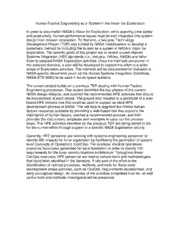
Human Factors Engineering as a System in the Vision for Exploration PDF
Preview Human Factors Engineering as a System in the Vision for Exploration
Human Factors Engineering as a System in the Vision for Exploration In order to accomplish NASA’s Vision for Exploration, while assuring crew safety and productivity, human performance issues must be well integrated into system design from mission conception. To that end, a two-year Technology Development Project (TDP) was funded by NASA Headquarters to develop a systematic method for including the human as a system in NASA’s Vision for Exploration. The specific goals of this project are to review current Human Systems Integration (HSI) standards (i.e., industry, military, NASA) and tailor them to selected NASA Exploration activities. Once the methods are proven in the selected domains, a plan will be developed to expand the effort to a wider scope of Exploration activities. The methods will be documented for inclusion in NASA-specific documents (such as the Human Systems Integration Standards, NASA-STD-3000) to be used in future space systems. The current project builds on a previous TDP dealing with Human Factors Engineering processes. That project identified the key phases of the current NASA design lifecycle, and outlined the recommended HFE activities that should be incorporated at each phase. The project also resulted in a prototype of a web- based HFE process tool that could be used to support an ideal HFE development process at NASA. This will help to augment the limited human factors resources available by providing a web-based tool that explains the importance of human factors, teaches a recommended process, and then provides the instructions, templates and examples to carry out the process steps. The HFE activities identified by the previous TDP are being tested in situ for the current effort through support to a specific NASA Exploration activity. Currently, HFE personnel are working with systems engineering personnel to identify HSI impacts for lunar exploration by facilitating the generation of system- level Concepts of Operations (ConOps). For example, medical operations scenarios have been generated for lunar habitation in order to identify HSI requirements for the lunar communications architecture. Throughout these ConOps exercises, HFE personnel are testing various tools and methodologies that have been identified in the literature. A key part of the effort is the identification of optimal processes, methods, and tools for these early development phase activities, such as ConOps, requirements development, and early conceptual design. An overview of the activities completed thus far, as well as the tools and methods investigated will be presented.
